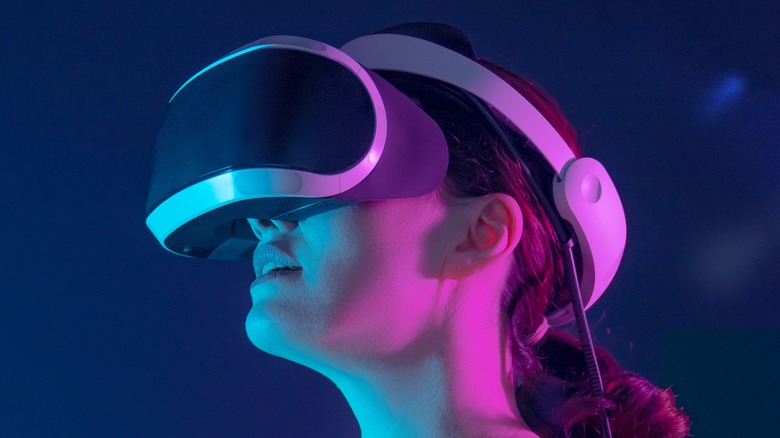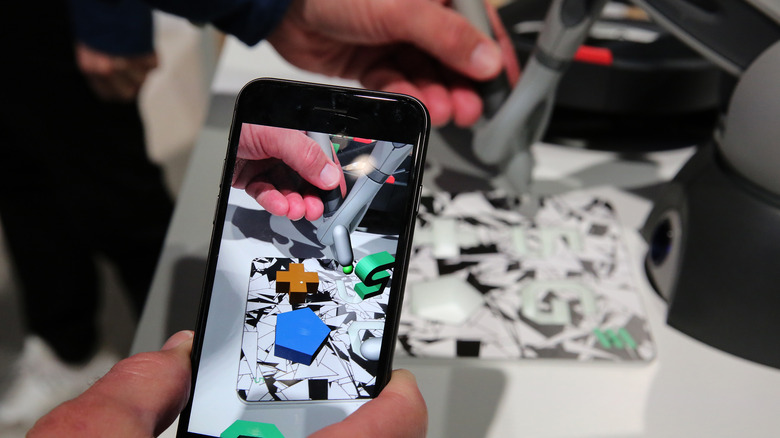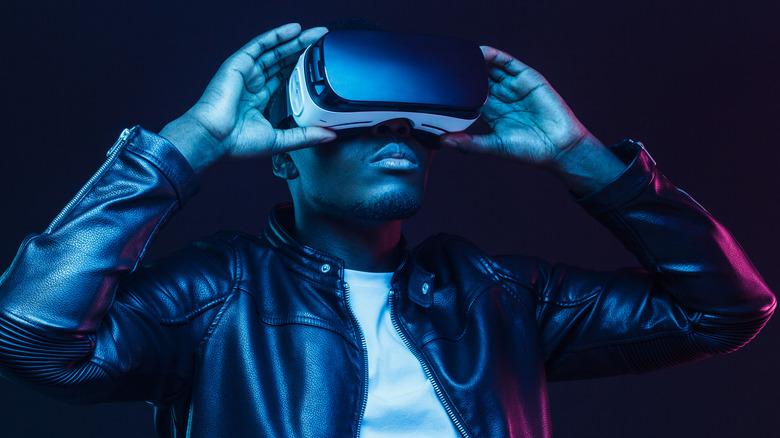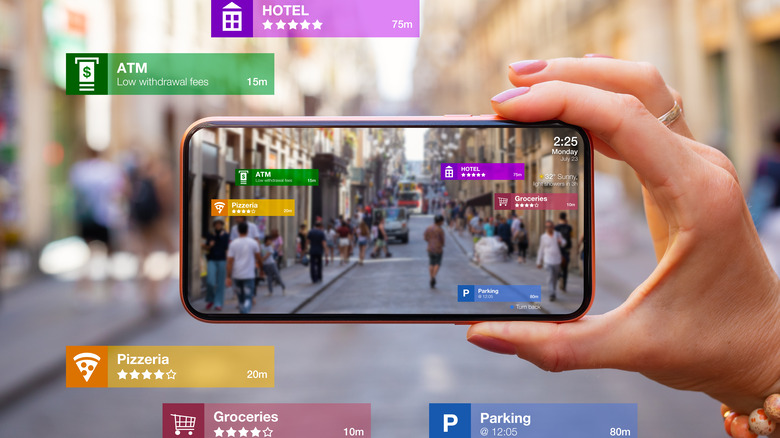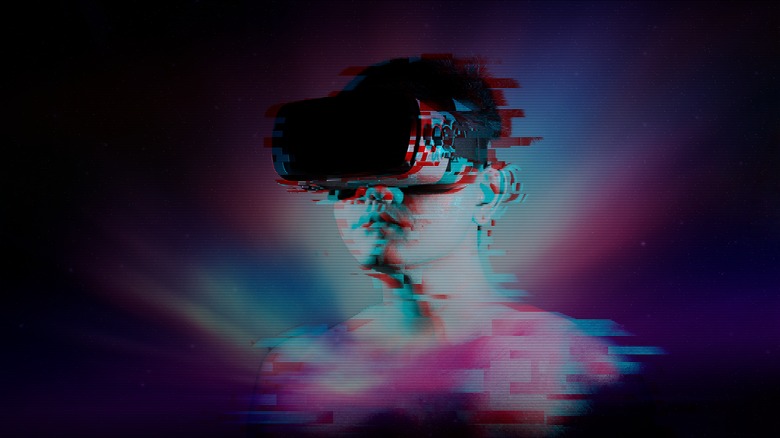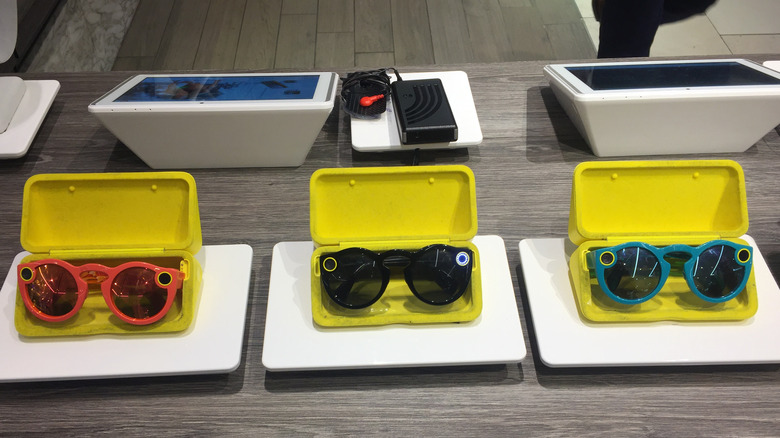What's The Difference Between VR And AR?
Virtual reality has been growing in popularity, with tons of headsets on the market that allow people to experience immersive digital worlds. If you're just now learning about the technology behind exploring these virtual environments, you may have discovered the terms VR and AR. Although similar, these two types of technology work in very different ways to alter your experience with reality. Namely, the differences lie in how much physical reality is included in the experience.
VR stands for virtual reality, whereas AR stands for augmented reality. Virtual reality is certainly the most immersive of the two, requiring a full headset and, for the most part, putting you in an entirely different virtual world than the physical reality around you. Augmented reality, on the other hand, combines virtual elements with physical reality using a camera, such as the one on your smartphone or tablet. This puts virtual objects in the world you see around you. It's less immersive than VR but can still be a pretty intriguing experience with unique use cases.
What is VR?
Virtual reality uses a headset that covers your field of vision. This allows you to become fully immersed in a virtual world, as noted by the Virtual Reality Society. You also may have controllers you can use to explore the world, apps, or games within the headset. VR headsets create a brand new reality around you; you aren't necessarily interacting with the physical world. Sometimes, certain apps or games may incorporate parts of physical reality, but in most instances they tend to stay separate.
The goal of VR is to transport you to a virtual world. It's much more expansive in scope than AR technology, allowing you to explore new places while still being in the comfort of your home. VR is mainly used for games, chatting with others in a virtual setting, or watching videos and movies in a private space. It has many more capabilities than AR does and can be used for a variety of purposes.
What is AR?
Augmented reality is quite a bit different from virtual reality. First, it doesn't require a headset to use. Typically, these experiences are made possible by using a device with a camera, such as a smartphone. The app or game changes the imagery of the physical world you see through the camera. Sometimes, VR headsets will also use AR technology. It's done by analyzing the image through the camera in order to accurately place virtual objects. This is used in many smartphone apps for entertainment, such as Snapchat and Pokemon Go. It can also be used for practical purposes, however, such as in the IKEA app that allows you to see how furniture would look in your home via AR.
You can get special physical objects that work with AR via object recognition. Users can manipulate the physical object to get a different outcome in augmented reality. Object recognition works with a camera by analyzing the item made specifically for AR purposes and finding specific markers, as explained by Roundtable Learning. Once it recognizes the physical object, it creates the virtual 3D object associated with it on the device being used.
What's the difference between AR and VR?
Where VR is an immersive experience, transporting you completely into a virtual world, AR is more focused on blending both physical reality and virtual reality. Virtual reality needs a headset to offer the experience so that it can occupy your full field of vision. This means nothing from your physical environment will be in view. This is much different than augmented reality, which can use a device that has camera capabilities even if it isn't a headset. This technology works by analyzing the environment through the camera — such as the one on a smartphone — and placing virtual, 3D objects or 2D overlays within it.
These technologies are similar in a very surface-level way in that they both combine reality with virtual reality. They can also both be used as learning devices or to relay information in more novel and impactful ways. From there, though, there aren't many other similarities, and they tend to serve quite different purposes, such as AR headsets being used for retrieving information while working in the field and VR headsets being used to play games or experience unique environments.
VR and AR benefits
Virtual and augmented reality technologies have many benefits, and each one can offer something different. When it comes to VR devices, they can be used for any number of immersive experiences like games or watching movies in a private "theater." However, they can also be useful for remote meetings or chatrooms and make for a much more personal environment that goes a step beyond video chats. Virtual reality can also be useful in job trainings or for learning to help people retain information in novel ways or to create more realistic experiences.
Augmented reality also has its practical uses. It can be used for seeing information about the environment around you by overlaying that information in real-time. The technology can also be used to make virtual changes to physical reality that are viewable through a supported device, such as placing furniture. AR can also be used for the purposes of job training to give real-time information to help people learn more through experience, such as seeing technical specifications for something they're looking at.
VR and AR negatives
These two technologies do, however, have some limitations in what they can accomplish. Augmented reality is very limited currently and its ability to analyze the outer environment isn't advanced enough to be useful for the everyday person. It also lacks the ability to really immerse someone in a virtual environment, compared to what VR can do. Also, most AR technology needs to have some sort of object identifiable by the camera in order to use it.
Virtual reality isn't without its faults, either. The tech isn't as useful for providing information in real-world scenarios in real-time, which can be helpful in learning or job training. At this point, some of the technology can also be a bit clumsy and unintuitive. This is important because you have to rely on this technology to fully experience the virtual world it provides you. Both of these technologies still have a long way to go before they can truly become integrated parts of daily life.
Which headsets support VR and AR?
There are a growing number of headsets on the market that offer virtual or augmented reality capabilities, though some of them are only made available to enterprise customers for business or training purposes. Arguably the most popular VR headset available for anyone to purchase is Meta's Oculus platform, which has shed the tether that was found on the Rift S model to offer a fully wireless experience with Oculus Quest 2. Meta faces some stiff competition from other companies selling similar products, however, including HTC with its Vive platform and Valve with its Index.
There are fewer headset options when it comes to augmented reality, as this technology falls more into the "smart glasses" category. The best-known AR wearable at this time is Microsoft's Hololens, but that platform isn't available for the average consumer to purchase. Instead, individuals interested in experiencing this tech may want to look into something like Snapchat Spectacles, which are a type of smart glasses that use a camera and lenses to overlay virtual elements onto the real world. Even then, however, these smart glasses have limited availability and will be difficult to acquire.
